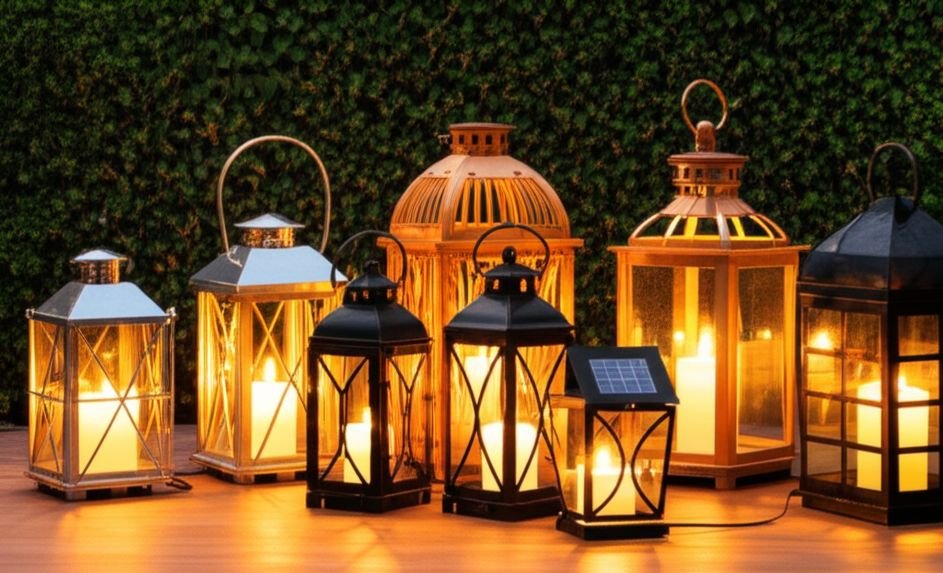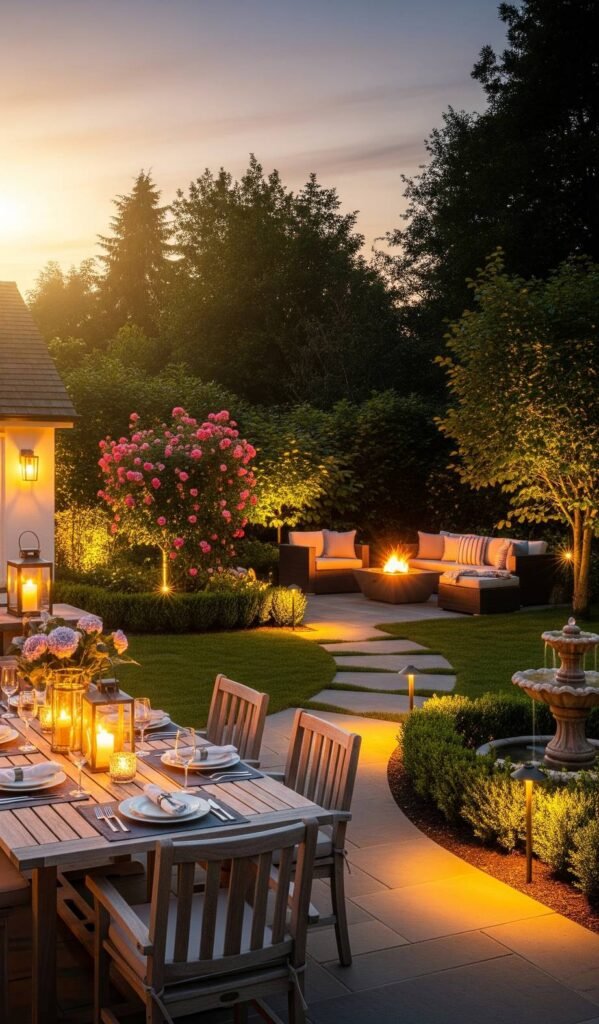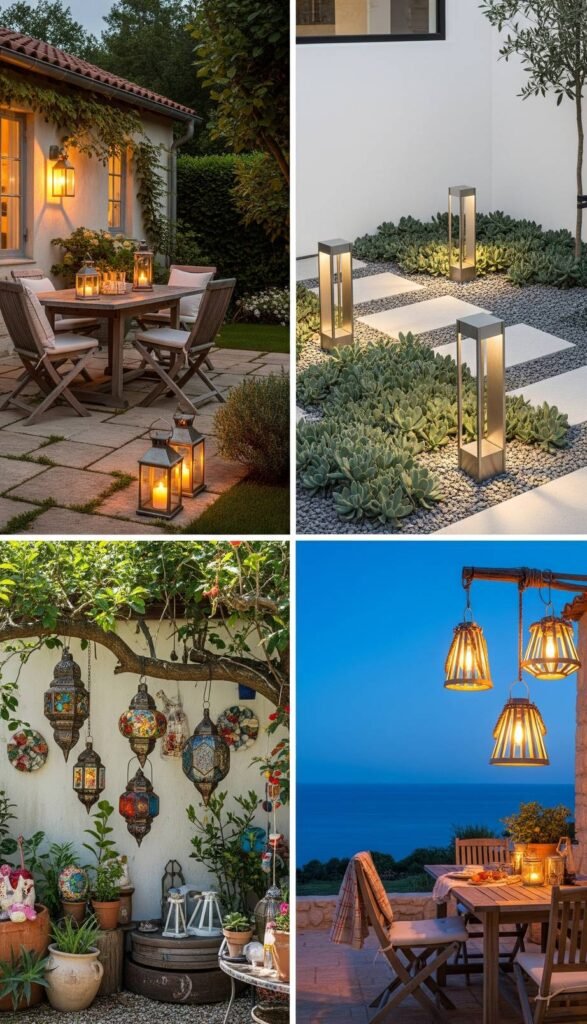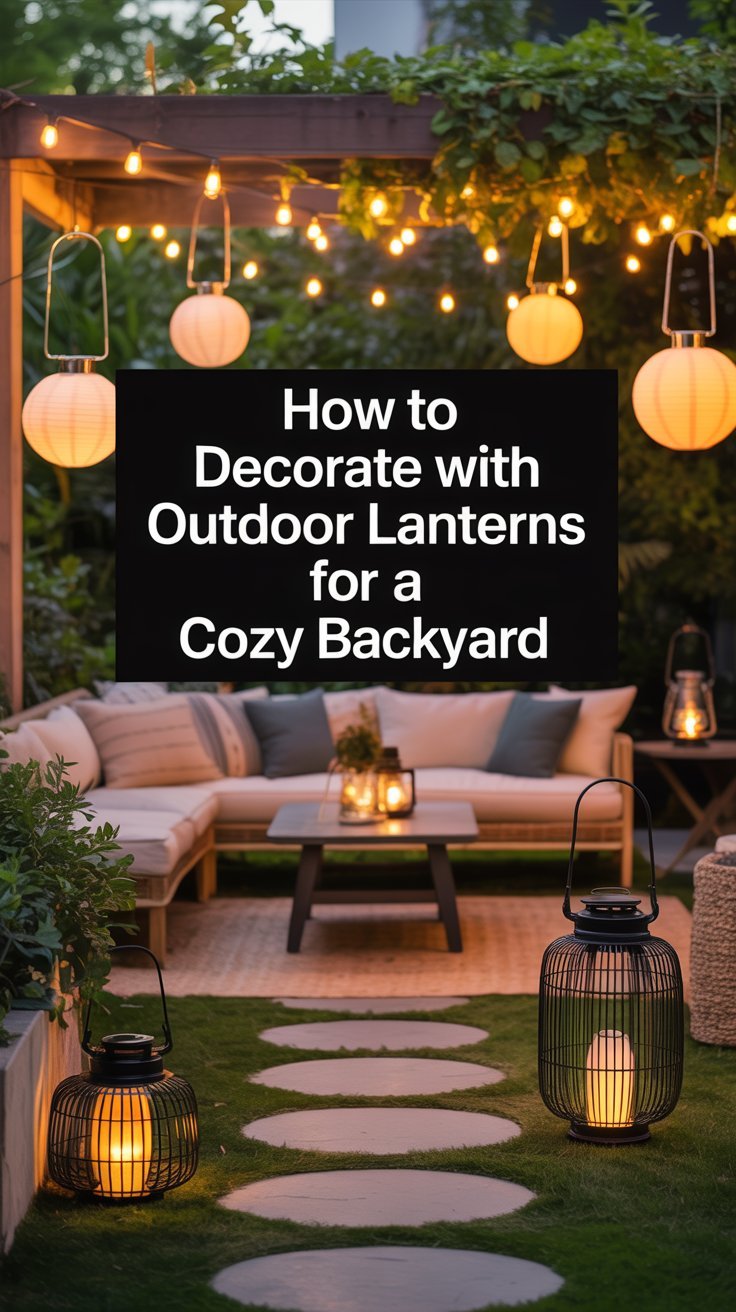How to Decorate with Outdoor Lanterns for a Cozy Backyard
Creating a cozy backyard retreat involves thoughtful design and the strategic use of lighting. Outdoor lanterns are versatile elements that can enhance ambiance, provide functional illumination, and add a touch of personal style to your outdoor space.
This comprehensive guide will walk you through the various aspects of decorating with outdoor lanterns, ensuring your backyard becomes a welcoming and relaxing haven.
1. Understanding the Different Types of Outdoor Lanterns

Choosing the right type of outdoor lantern is the first step in creating your desired atmosphere. Lanterns vary in their power source, material, and style. Understanding these differences will help you select options that best suit your needs and the overall aesthetic of your backyard.
1.1. Power Sources
- Electric Lanterns: These lanterns typically require wiring to an electrical outlet or a low-voltage lighting system. They offer consistent and reliable light output. Electric lanterns are suitable for fixed locations like patios, decks, and pathways where wiring is feasible. They often come with features like dimmers and timers, providing greater control over the lighting.
- Solar-Powered Lanterns: Solar lanterns absorb sunlight during the day and automatically illuminate at dusk. They are energy-efficient and require no wiring, making them easy to install and relocate. Solar lanterns are ideal for lining walkways, illuminating garden beds, and adding ambient light to seating areas. Their brightness and longevity may vary depending on the amount of sunlight they receive.
- Candle Lanterns: These lanterns create a warm and flickering glow using real or LED candles. They are portable and add a romantic and traditional touch to outdoor settings. Candle lanterns are perfect for tabletops, hanging from pergolas, or as decorative accents. Ensure that real candles are used safely in appropriate holders and are not left unattended.
- Battery-Operated Lanterns: Powered by batteries, these lanterns offer flexibility in placement as they don’t require wiring or sunlight. LED battery-operated lanterns can provide a significant amount of light and often have timer functions. They are a good option for temporary lighting or areas where other power sources are not readily available.
1.2. Materials and Styles
Outdoor lanterns are available in a wide range of materials, each contributing to a different aesthetic and level of durability.
- Metal Lanterns: Options include wrought iron, stainless steel, and copper. Metal lanterns are often robust and can withstand various weather conditions. They can range in style from rustic and traditional to sleek and modern.
- Wooden Lanterns: Wooden lanterns bring a natural and warm element to outdoor decor. They are often used for more rustic or bohemian themes. Ensure that wooden lanterns are treated or made from weather-resistant wood to prevent damage.
- Glass Lanterns: Glass lanterns can feature clear, frosted, or colored glass, allowing for different light diffusion effects. They are often paired with metal or wooden frames and can add an elegant or vintage touch.
- Plastic or Resin Lanterns: These are often lightweight, durable, and more affordable options. They can mimic the look of other materials and are well-suited for various outdoor environments.
Consider the overall style of your backyard when choosing lantern materials and designs. Match the lanterns to your existing furniture, landscaping, and architectural elements for a cohesive look.
2. Planning Your Outdoor Lantern Placement

Strategic placement of outdoor lanterns is crucial for both aesthetics and functionality. Consider how you use your backyard and identify areas that would benefit from illumination and decorative accents.
2.1. Defining Zones
Divide your backyard into different zones based on their function, such as dining areas, seating areas, walkways, and garden beds. This will help you determine the type and amount of lighting needed in each zone.
- Dining Areas: Opt for brighter, more direct light above or around the dining table. Consider hanging pendant lanterns or placing lanterns on a nearby surface.
- Seating Areas: Aim for softer, ambient lighting to create a relaxed and intimate atmosphere. Table lanterns, floor lanterns, or lanterns hung at lower levels can work well.
- Walkways and Pathways: Use ground-level lanterns or path lights to ensure safety and guide movement. Solar stake lights or low-profile lanterns are effective options.
- Garden Beds and Features: Highlight interesting plants, sculptures, or water features with strategically placed spotlights or lanterns. This can add depth and visual interest to your landscape at night.
2.2. Creating Layers of Light
A well-lit backyard incorporates different layers of light to create dimension and avoid a flat, overly bright appearance.
- Ambient Lighting: Provides overall illumination to the space. String lights, hanging lanterns, and strategically placed floor lanterns contribute to ambient lighting.
- Task Lighting: Illuminates specific areas for activities like dining or reading. Pendant lights above a table or brighter lanterns near a seating area serve as task lighting.
- Accent Lighting: Highlights specific features or adds decorative touches. Spotlights on plants, lanterns illuminating a fountain, or decorative lanterns placed on shelves provide accent lighting.
By layering your lighting, you can create a more dynamic and visually appealing outdoor space.
2.3. Considering Height and Scale
The height at which you place your lanterns and their size relative to the surrounding elements are important considerations.
- Hanging Lanterns: Ensure that hanging lanterns are at a height that doesn’t obstruct movement or conversation. Over a dining table, aim for a height that provides ample light without being too close to guests’ faces.
- Table Lanterns: Choose sizes that are appropriate for the size of the table. A large lantern can serve as a centerpiece, while smaller lanterns can be grouped together.
- Floor Lanterns: Consider the height of nearby furniture and ensure the lanterns are proportionate to the space.
- Pathway Lanterns: Keep pathway lanterns low to the ground to illuminate the path without creating glare.
Pay attention to the scale of the lanterns in relation to the size of your backyard and the surrounding features. Oversized lanterns in a small space can feel overwhelming, while undersized lanterns in a large area may get lost.
3. Incorporating Lanterns into Different Backyard Styles

The style of your outdoor lanterns should complement the overall design aesthetic of your backyard. Different styles evoke different moods and atmospheres.
3.1. Rustic and Farmhouse Styles
For a rustic or farmhouse-inspired backyard, opt for lanterns made from natural materials like wood, wrought iron, or aged metals. Candle lanterns or electric lanterns with a vintage aesthetic work well. Place lanterns on wooden tables, hang them from pergolas with natural rope, or use them to flank doorways and pathways. The light emitted should be warm and inviting, enhancing the cozy and unpretentious feel.
3.2. Modern and Minimalist Styles
Modern backyards benefit from lanterns with clean lines, geometric shapes, and materials like stainless steel, brushed aluminum, or clear glass. Choose lanterns that provide focused and functional light. Consider placing sleek floor lanterns near seating areas or using minimalist pathway lights along walkways. The lighting should be sophisticated and understated, complementing the uncluttered aesthetic.
3.3. Bohemian and Eclectic Styles
Bohemian and eclectic backyards embrace a mix of colors, patterns, and textures. Incorporate lanterns in various styles, materials, and sizes. Moroccan-style lanterns with intricate metalwork and colored glass, vintage lanterns found at flea markets, and string lights with unique bulbs can all contribute to the bohemian vibe. Hang lanterns at varying heights, group them together for a layered effect, and don’t be afraid to mix and match different styles. The lighting should be warm and whimsical, creating a relaxed and inviting atmosphere.
3.4. Mediterranean and Coastal Styles
For Mediterranean or coastal-themed backyards, choose lanterns made from natural materials like rope, weathered wood, ceramic, or wrought iron with a nautical feel. Opt for warm-toned light that complements the earthy tones and natural textures of these styles. Hang lanterns from pergolas or trees, place them on stone walls or patios, or use them to illuminate outdoor kitchens or dining areas. The lighting should evoke a sense of warmth and relaxation, reminiscent of seaside evenings.
4. Creative Ways to Use Outdoor Lanterns
Beyond traditional placement, there are numerous creative ways to incorporate outdoor lanterns into your backyard decor, adding personality and visual interest.
4.1. Lantern Centerpieces
Group several lanterns of different sizes, shapes, and materials together to create a captivating centerpiece for your outdoor dining table or coffee table. You can use real candles, LED candles, or even fill the lanterns with decorative items like smooth stones, seashells, or fairy lights for a unique touch.
4.2. Lantern Pathways and Borders
Line your garden paths, flower beds, or the edges of your patio with lanterns to create a soft and inviting glow. Solar stake lights are a convenient option for pathways, while decorative lanterns can be placed along borders to define spaces and add visual interest.
4.3. Hanging Lantern Clusters
Create a dramatic lighting feature by hanging multiple lanterns at varying heights from a pergola, gazebo, tree branches, or even a sturdy outdoor umbrella. Use different sizes and styles of lanterns for a more eclectic look, or stick to a consistent theme for a more uniform appearance.
4.4. Lanterns as Decorative Accents
Use lanterns as decorative accents on shelves, steps, or retaining walls. You can even repurpose larger lanterns as unique planters for succulents or trailing plants. Consider filling lanterns with non-traditional items like colorful glass pebbles or small decorative figurines to match your theme.
4.5. Integrating Lanterns with Other Lighting
Combine lanterns with other types of outdoor lighting, such as string lights, spotlights, and wall sconces, to create a layered and well-balanced lighting scheme. Use lanterns to provide ambient or accent lighting, while other fixtures offer task lighting or highlight specific features.
5. Maintaining and Caring for Your Outdoor Lanterns
Proper maintenance will ensure that your outdoor lanterns continue to look their best and function effectively for years to come. The specific care requirements will depend on the type of lantern and the materials it is made from.
5.1. Cleaning
Regularly clean your outdoor lanterns to remove dust, dirt, and debris. For metal and glass lanterns, wipe them down with a soft cloth and mild soapy water. Avoid using harsh chemicals or abrasive cleaners that could damage the finish. Wooden lanterns may require occasional cleaning with a damp cloth and a wood-specific cleaner or protector. Plastic or resin lanterns can typically be cleaned with soap and water.
5.2. Bulb and Battery Replacement
For electric lanterns, check and replace light bulbs as needed. Ensure you are using the correct type and wattage of bulb as recommended by the manufacturer. For solar-powered lanterns, the rechargeable batteries will eventually need to be replaced. Refer to the manufacturer’s instructions for the correct type of replacement battery and the proper procedure. Battery-operated lanterns will also require periodic battery changes.
5.3. Weather Protection
While most outdoor lanterns are designed to withstand typical weather conditions, extreme weather can still cause damage. Consider bringing delicate lanterns indoors during severe storms or the off-season. For permanently installed lanterns, check for any signs of corrosion, rust, or damage, and address them promptly to prevent further deterioration. Applying a protective sealant to metal or wooden lanterns can help prolong their lifespan.
5.4. Winter Storage
If you live in an area with harsh winters, it’s advisable to store your outdoor lanterns in a dry, protected place during the colder months. This will help prevent damage from freezing temperatures, snow, and ice. Clean the lanterns thoroughly before storing them.
